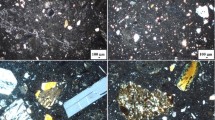Abstract
Bowing of thin marble slabs is a phenomenon affecting both historic monuments and modern buildings. In spite of the ubiquity and destructiveness of this phenomenon, no fully satisfactory treatment is currently available to arrest and/or prevent bowing. In this study, a treatment based on formation of hydroxyapatite (HAP) was investigated as a possible route to arrest and possibly prevent bowing of Carrara marble slabs. Four different formulations of the HAP treatment were tested and compared to ammonium oxalate and ethyl silicate (widely used in the practice of marble conservation). The treatments were applied onto pre-weathered and unweathered specimens to investigate their ability to arrest and prevent bowing, respectively. Marble behavior was studied in terms of residual strain and bowing after thermal cycles up to 90 °C in dry and wet conditions. Marble cohesion was assessed before and after the thermal cycles by ultrasound. The HAP treatments exhibited promising results, as the residual strain and the bowing after the cycles were always lower or equal to the untreated references, while marble cohesion was always higher. Surprisingly, ammonium oxalate caused marked worsening of marble thermal behavior. In the case of ethyl silicate, most of the initial benefit after consolidation was lost after the thermal cycles. In general, the results of the study point out the importance of evaluating marble thermal behavior to assess the suitability of any conservation treatment and suggest that treatments able to strengthen marble without causing excessive pore occlusion and stiffening are preferable to enhance durability to thermal cycles.












Similar content being viewed by others
References
Atkinson BK (1984) Subcritical crack growth in geological materials. J Geophys Res 89:4077–4114. https://doi.org/10.1029/JB089iB06p04077
Bonazza A, Sabbioni C, Messina P, Guaraldi C, De Nuntiis P (2009) Climate change impact: mapping thermal stress on Carrara marble in Europe. Sci Total Environ 407:4506–4512. https://doi.org/10.1016/j.scitotenv.2009.04.008
Conti C, Casati M, Colombo C, Possenti P, Realini M, Gatta GD, Merlini M, Brambilla L, Zerbi G (2015) Synthesis of calcium oxalate trihydrate: new data by vibrational spectroscopy and synchrotron X-ray diffraction. Spectrochim Acta A 150:721–730. https://doi.org/10.1016/j.saa.2015.06.009
European Standard EN 16306 (2013) Natural stone test methods—determination of resistance of marble to thermal and moisture cycles
Franzoni E, Sassoni E, Graziani G (2015a) Brushing, poultice or immersion? Role of the application technique on the performance of a novel hydroxyapatite-based consolidating treatment for limestone. J Cult Herit 16:173–184. https://doi.org/10.1016/j.culher.2014.05.009
Franzoni E, Graziani G, Sassoni E (2015b) TEOS-based treatments for stone consolidation: acceleration of hydrolysis-condensation reactions by poulticing. J Sol Gel Sci Technol 74:398–405. https://doi.org/10.1007/s10971-014-3610-3
Frost RL, Weier ML (2004) Thermal treatment of whewellite—a thermal analysis and Raman spectroscopic study. Thermochim Acta 409:79–85. https://doi.org/10.1016/S0040-6031(03)00332-0
Graziani G, Sassoni E, Franzoni E, Scherer GW (2016) Hydroxyapatite coatings for marble protection: optimization of calcite covering and acid resistance. Appl Surf Sci 368:241–257. https://doi.org/10.1016/j.apsusc.2016.01.202
Graziani G, Sassoni E, Scherer GW, Franzoni E (2017) Penetration depth and redistribution of an aqueous ammonium phosphate solution used for porous limestone consolidation by brushing and immersion. Constr Build Mater 148:571–578. https://doi.org/10.1016/j.conbuildmat.2017.05.097
Grimm WD (1999) Beobachtungen und Überlegungen zur Verformung von Marmorobjekten durch Gefügeauflockerung. Zeitschrift der Deutschen Geologischen Gesellschaft 150/2:195–236 (in German)
Jornet A, Teruzzi T, Rück P (2002) Bowing of Carrara marble slabs: comparison between natural and artificial weathering. In: Prikryl R, Viles HA Understanding and managing of stone decay (SWAPNET 2001). Karolinum Press, Prague, pp 161–170
Kieslinger A (1934) Gesteinskundliche Untersuchungen an alten Grabsteinen. Geologie Bauwesen 6:1–21 (in German)
Koch A (2006) Deformation von Fassadenplatten aus Marmor. Universitätsverlag Göttingen, Ph.D. Thesis (in German)
Koch A, Siegesmund S (2004) The combined effect of moisture and temperature on the anomalous expansion behaviour of marble. Environ Geol 46:350–363. https://doi.org/10.1007/s00254-004-1037-9
Köhler W (1988) Preservation problems of Carrara Marble sculptures in Potsdam Sanssouci (“Radial structural destruction of Carrara Marble”). In: Proceedings of the 6th International Congress on Deterioration and Conservation of Stone, Torun, pp 653–662
Koutsopoulos S (2002) Synthesis and characterization of hydroxyapatite crystals: a review study on the analytical methods. J Biomed Mater Res 15:600–612. https://doi.org/10.1002/jbm.10280
Liu Q, Zhang B (2011) Synthesis and characterization of a novel biomaterial for the conservation of historic stone building and sculptures. Mater Sci Forum 675–677:317–320
Logan JM (2004) Laboratory and case studies of thermal cycling and stored strain on the stability of selected marbles. Environ Geol 46:456–467. https://doi.org/10.1007/s00254-004-1047-7
Logan JM, Hadedt M, Lehnert D, Denton M (1993) A case study of the properties of marble as building veneer. Int J Rock Mech Min 30:1531–1537. https://doi.org/10.1016/0148-9062(93)90152-4
Ma X, Balonis M, Pasco H, Toumazou M, Counts D, Kakoulli I (2017) Evaluation of hydroxyapatite effects for the consolidation of a Hellenistic–Roman rock-cut chamber tomb at Athienou-Malloura in Cyprus. Constr Build Mater 150:333–344. https://doi.org/10.1016/j.conbuildmat.2017.06.012
Malaga K, Schouenborg B, Alnaes L, Bellopede R, Brundin JA (2004) Field exposure sites and accelerated laboratory test of marble panels. In: Prikryl (ed) Dimension stone, proceedings of the international conference on dimension stone, 14–17 June 2004, Prague (CZ), pp 261–266
Malaga-Starzec K, Lindqvist JE, Schouenborg B (2002) Experimental study on the variation in porosity of marble as a function of temperature. In: Siegesmund S, Weiss T, Vollbrecht A (eds) Natural stone, weathering phenomena, conservation strategies and case studies, vol 205. Geological Society Special Publications, London, pp 81–88. https://doi.org/10.1144/GSL.SP.2002.205.01.07
Malaga-Starzec K, Åkesson U, Lindqvist JE, Schouenborg B (2006) Microscopic and macroscopic characterization of the porosity of marble as a function of temperature and impregnation. Constr Build Mater 20:939–947. https://doi.org/10.1016/j.conbuildmat.2005.06.016
Marini P, Bellopede R (2009) Bowing of marble slabs: evolution and correlation with mechanical decay. Constr Build Mater 23:2599–2605. https://doi.org/10.1016/j.conbuildmat.2009.02.010
Matteini M, Rescic S, Fratini F, Botticelli G (2011) Ammonium phosphates as consolidating agents for carbonatic stone materials used in architecture and cultural heritage: Preliminary research. Int J Archit Herit 5:717–736. https://doi.org/10.1080/15583058.2010.495445
Molina E, Rueda-Quero L, Benavente D, Burgos-Cara A, Ruiz-Agudo E, Cultrone G (2017) Gypsum crust as a source of calcium for the consolidation of carbonate stones using a calcium phosphate-based consolidant. Constr Build Mater 143:298–311. https://doi.org/10.1016/j.conbuildmat.2017.03.155
Naidu S, Scherer GW (2014) Nucleation, growth and evolution of calcium phosphate films on calcite. J Colloid Interf Sci 435:128–137. https://doi.org/10.1016/j.jcis.2014.08.018
Naidu S, Sassoni E, Scherer GW (2011) New treatment for corrosion-resistant coatings for marble and consolidation of limestone. In: Stefanaggi M, Vergès-Belmin V (eds) Jardins de Pierres—Conservation of stone in Parks, Gardens and Cemeteries, Paris (F) 22–24 June 2011, pp 289–294
Naidu S, Liu C, Scherer GW (2015) Hydroxyapatite-based consolidant and the acceleration of hydrolysis of silicate-based consolidants. J Cult Herit 16:94–101. https://doi.org/10.1016/j.culher.2014.01.001
Naidu S, Blair J, Scherer GW (2016) Acid-resistant coatings on marble. J Am Ceram Soc 99:3421–3428. https://doi.org/10.1111/jace.14355
Osticioli I, Botticelli G, Matteini P, Siano S, Pini R, Matteini M (2017) Micro-Raman analysis on the combined use of ammonium oxalate and ammonium phosphate for the consolidation and protection of carbonate stone artifacts. J Raman Spectrosc 48:966–971. https://doi.org/10.1002/jrs.5150
Pamplona M, Simon S (2012) Ultrasonic pulse velocity—a tool for the condition assessment of outdoor marble sculptures. In: Proceedings of 12th international congress on deterioration and conservation of stone, New York City (USA), 22–26 October 2012, pp 1–13. http://iscs.icomos.org/pdf-files/NewYorkConf/pampsimo.pdf
Possenti E, Colombo C, Bersani D, Bertasa M, Botteon A, Conti C, Lottici PP, Realini M (2016) New insight on the interaction of diammonium hydrogenphosphate conservation treatment with carbonatic substrates: a multi-analytical approach. Microchem J 127:79–86. https://doi.org/10.1016/j.microc.2016.02.008
Rayleigh (1934) The bending of marble. Proc R Soc Lond Ser A Contain Papers Math Phys Character 144:266–279. http://www.jstor.org/stable/2935557
Royer-Carfagni G (1999) Some considerations on the warping of marble façades: the example of Alvar Aalto’s Finland Hall In Helsinki. Constr Build Mater 13:449–457. https://doi.org/10.1016/S0950-0618(99)00036-7
Ruedrich J, Weiss T, Siegesmund S (2002) Thermal behavior of weathered and consolidated marbles. In: Siegesmund S, Weiss T, Vollbrecht A (eds) Natural stone, weathering phenomena, conservation strategies and case studies, vol 205. Geological Society Special Publications, London, pp 255–271. https://doi.org/10.1144/GSL.SP.2002.205.01.19
Sassoni E (2017) Phosphate-based treatments for conservation of stone. RILEM Tech Lett 2:14–19. https://doi.org/10.21809/rilemtechlett.2017.34
Sassoni E, Franzoni E (2014a) Sugaring marble in the Monumental Cemetery in Bologna (Italy): characterization of naturally and artificially weathered samples and first results of consolidation by hydroxyapatite. Appl Phys A Mater 117:1893–1906. https://doi.org/10.1007/s00339-014-8629-3
Sassoni E, Franzoni E (2014b) Influence of porosity on artificial deterioration of marble and limestone by heating. Appl Phys A Mater 115:809–816. https://doi.org/10.1007/s00339-013-7863-4
Sassoni E, Naidu S, Scherer GW (2011) The use of hydroxyapatite as a new inorganic consolidant for damaged carbonate stones. J Cult Herit 12:346–355. https://doi.org/10.1016/j.culher.2011.02.005
Sassoni E, Graziani G, Franzoni E (2015) Repair of sugaring marble by ammonium phosphate: comparison with ethyl silicate and ammonium oxalate and pilot application to historic artifact. Mater Design 88:1145–1157. https://doi.org/10.1016/j.matdes.2015.09.101
Sassoni E, Graziani G, Ridolfi G, Bignozzi MC, Franzoni E (2017) Thermal behavior of Carrara marble after consolidation by ammonium phosphate, ammonium oxalate and ethyl silicate. Mater Design 120:345–353. https://doi.org/10.1016/j.matdes.2017.02.040
Sassoni E, Graziani G, Franzoni E, Scherer GW (2018a) Calcium phosphate coatings for marble conservation: influence of ethanol and isopropanol addition to the precipitation medium on the coating microstructure and performance. Corros Sci 136:255–267. https://doi.org/10.1016/j.corsci.2018.03.019
Sassoni E, Graziani G, Franzoni E, Scherer GW (2018b) New method for controllable accelerated aging of marble: use for testing of consolidants. J Am Ceram Soc. https://doi.org/10.1111/jace.15522
Shushakova V, Fuller ER Jr, Heidelbach F, Mainprice D, Siegesmund S (2013a) Marble decay induced by thermal strains: Simulations and experiments. Environ Earth Sci 69:1281–1297. https://doi.org/10.1007/s12665-013-2406-z
Shushakova V, Fuller ER Jr, Siegesmund S (2013b) Microcracking in calcite and dolomite marble: microstructural influences and effects on properties. Environ Earth Sci 69:1263–1279. https://doi.org/10.1007/s12665-012-1995-2
Siegesmund S, Weiss T, Vollbrecht T, Ullemeyer K (1999) Marble as a natural building stone: rock fabrics, physical and mechanical properties. Zeitschrift der Deutschen Geologischen Gesellschaft Band 150 Heft 2:237–257
Siegesmund S, Ullemeyer K, Weiss T, Tschegg EK (2000) Physical weathering of marbles caused by anisotropic thermal expansion. Int J Earth Sci 89:170–182. https://doi.org/10.1007/s005310050324
Siegesmund S, Ruedrich J, Koch A (2008) Marble bowing: comparative studies of three different public building facades. Environ Geol 56:473–494. https://doi.org/10.1007/s00254-008-1307-z
TEAM project (2005) Technical final report. http://buildingteam.extweb.sp.se/PDF/TEAM%20Final%20Report.pdf
Weiss T, Rasolofosaon PNJ, Siegesmund S (2002) Ultrasonic wave velocities as a diagnostic tool for the quality assessment of marble. In: Siegesmund S, Weiss T, Vollbrecht A (eds) Natural stone, weathering phenomena, conservation strategies and case studies, vol 205. Geological Society Special Publications, London, pp 149–164. https://doi.org/10.1144/GSL.SP.2002.205.01.12
Weiss T, Siegesmund S, Fuller ER Jr (2003) Thermal degradation of marble: Indications from finite-element modelling. Build Environ 38:1251–1260. https://doi.org/10.1016/S0360-1323(03)00082-9
Wiedemann G, Bayer G (1988) Kinetics of the formation of whewellite and weddelite by displacement reactions. J Therm Anal 33:707–718. https://doi.org/10.1007/BF02138577
Yang F, Liu Y (2014) Artificial hydroxyapatite film for the conservation of outdoor marble artworks. Mater Lett 124:201–203. https://doi.org/10.1016/j.matlet.2014.03.081
Yang F, Zhang B, Liu Y, Guofeng W, Zhang H, Cheng W, Xu Z (2011) Biomimic conservation of weathered calcareous stones by apatite. New J Chem 35:887–892. https://doi.org/10.1039/C0NJ00783H
Zhang D, Tamilselvan A (2007) Lattice energy and mechanical stiffness of hydroxyapatite. J Mater Sci Mater Med 18:79–87. https://doi.org/10.1007/s10856-006-0665-x
Acknowledgements
This project has received funding from the European Union’s Horizon 2020 research and innovation programme under the Marie Sklodowska-Curie Grant agreement no 655239 (HAP4MARBLE project, “Multi-functionalization of hydroxyapatite for restoration and preventive conservation of marble artworks”). Johanna Menningen and Christian Knell (University of Göttingen) are gratefully acknowledged for their help in setting up the dilatometric and bowing tests.
Author information
Authors and Affiliations
Corresponding author
Additional information
This article is part of a Topical Collection in Environmental Earth Sciences on “Stone in the Architectural Heritage: from quarry to monuments—environment, exploitation, properties and durability”, guest edited by Siegfried Siegesmund, Luís Sousa, and Rubén Alfonso López-Doncel.
Rights and permissions
About this article
Cite this article
Sassoni, E., Andreotti, S., Scherer, G.W. et al. Bowing of marble slabs: can the phenomenon be arrested and prevented by inorganic treatments?. Environ Earth Sci 77, 387 (2018). https://doi.org/10.1007/s12665-018-7547-7
Received:
Accepted:
Published:
DOI: https://doi.org/10.1007/s12665-018-7547-7




